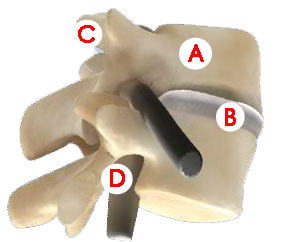Whiplash – Symptoms and Treatments
We’ve all heard the term, whiplash. It’s usually associated with a car accident. But what is a whiplash injury? What are the symptoms and how long do they last?

Neck Anatomy
The spine travels from the base of the skull down through the neck and back, all the way to the tailbone. This complicated structure of bones and soft tissues helps protect sensitive nerves and supports the head, while allowing for multi-directional movement. The upper portion of the spine, from the base of the skull through the neck, is called the cervical area. (Check out our in-depth series to learn more about the anatomy of the spine.)
 The individual bones within the spine are called vertabrae. Each vertabra is a complex shape made up of a larger portion called the vertebral body (A), and bony extensions call facet joints (C). Neighboring vertebae meet at these facet joints, which allow for movement in various directions.
The individual bones within the spine are called vertabrae. Each vertabra is a complex shape made up of a larger portion called the vertebral body (A), and bony extensions call facet joints (C). Neighboring vertebae meet at these facet joints, which allow for movement in various directions.
Between each vertabrae lies a cushion-like disc (B). These inter-vertebral discs prevent the vertebrae from rubbing together and provide protection similar to a shock-absorber.
Muscles and ligaments surround the spine providing protection and allowing for movement.
Openings on the side of each verteabrae allow for nerves to pass through (D) from the spinal column to the rest of the body.
What Is a Whiplash Injury?
Whiplash is a generic term describing the forces on the body during a particular accident. However, the injuries caused by whiplash can vary.
Whiplash can affect various components of the complex spine, such as:
- muscles and ligaments can be stretched, or strained
- various soft tissue can be irritated, causing inflammation
- the outer layer of a disc can be torn
- a disc can herniate (ie: the internal material leak out, putting pressure on nerves)
- facet joints can be injured
- vertebrae can break
Inflammation can often make it difficult to diagnose the injury immediately after it’s occurred. In addition, some injuries (such as facet joint pain) can’t be seen on an x-ray or MRI.
Whiplash Symptoms
The symtoms of whiplash can vary, depending on the injury. Some examples include:
- Facet Joint Pain: This pain is usually felt toward the left or right side of the back of the neck. The pain may feel like muscle pain and the area may be tender to the touch.
- Disc Injury: Can cause pain when you move your neck.
- Muscle Strain: Muscle pain can be caused by an injury to the muscle or be the result of the muscles overworking, compensating for another injury.
- Nerve Pain: If the injury puts pressure on nerves, this can result in pain in the shoulders, arms and hands. Continued pressure on the nerve can lead to arm weakness and/or numbness.
- Cervicogenic Headaches: Headaches caused by problems in the neck are referred to as cervicogenic headaches. These are often described as migraine-like headaches.
- Lower Back Pain: Pain in the lower back is sometimes seen after whiploash if the discs or vertebrae in the lower back are injured.
How Long Does Whiplash Last?
Inflammation and soft tissue strains from whiplash usually heal within six to ten weeks. However, if a more permanent injury occurs (ie: disc herniation, bone fracture), the effects of the whiplash can last longer.
How is Whiplash Treated?
Whiplash treatment often involves strengthening the neck. Physical therapies often focus on posture and strengthening the muscles that support the neck. This helps prevent spine mis-alignment and unnecessary stress on the spine while healing.
Medications such as anti-inflammatories or injections can be used to help ease the pain while the patient is recovering.
Surgery is rarely needed to treat whiplash.
Reference: Whiplash and Whiplash Associated Disorder (spine.org)
